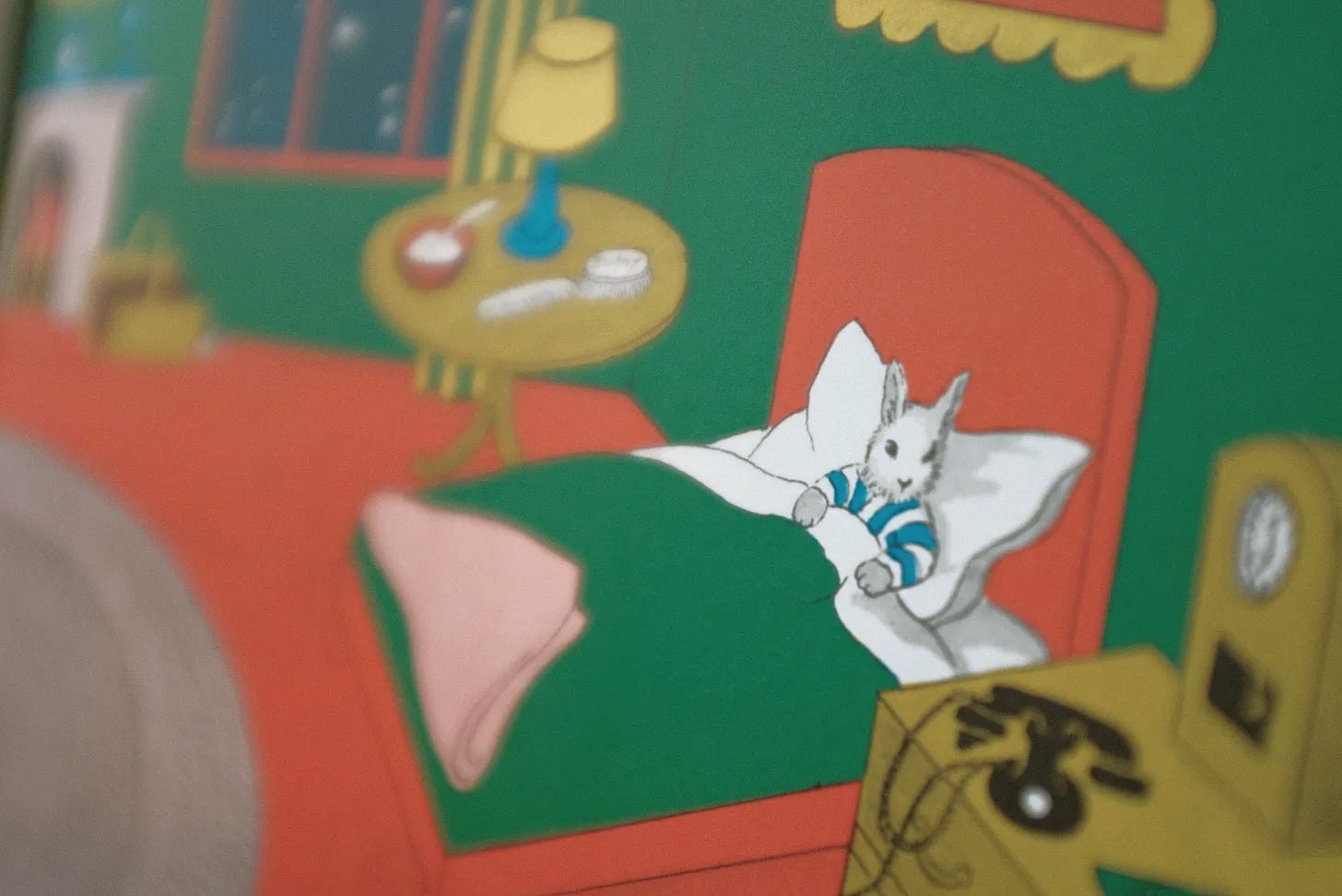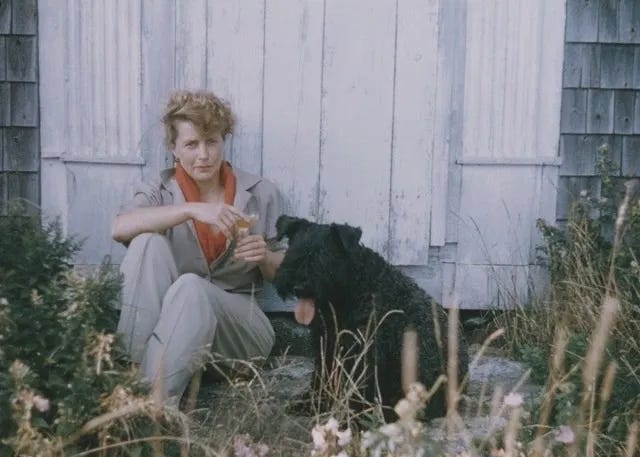Jon and Mac discuss a brilliant but little-known essay by Margaret Wise Brown, one of the twentieth century’s great children’s writers, the author of Goodnight Moon and many other classic picture books. They had this conversation over text.
MAC: When I was doing research for a picture book about Margaret Wise Brown…
(The Important Thing About Margaret Wise Brown, available in bookstores now)
(it came out 5 years ago, honestly it is probably not in many bookstores now) (if you ask your bookstore they will probably order a copy, bookstores are cool that way)
…I went to the Bank Street School of Education in New York City, where Margaret Wise Brown studied. She was going to be a schoolteacher so she could make money while she tried to become a poet.
It was at Bank Street that Brown first figured out that she wanted to write for children. The archivist there showed me an essay, typewritten by Margaret Wise Brown, called “Writing for Five Year Olds,” which is one of the best things about writing for children I’ve ever read.
For years, I thought the only accessible copy was a scan on my personal Google Drive account (it was taking up a significant amount of my allotted storage), but I now see that the good people at Bank Street have uploaded the essay to the internet.
That means that 1) I can link to it here and 2) I can free up some space on my Google Drive.
The whole essay is worth reading but I wanted to talk about the opening with you now. So here it is:
When a child reaches the age of five he is the sum total of all his younger experiences and discoveries in a brand new world. He carries with him the two-year-old's delight in sheer sound and pounding rhythms and the glamor of the two-year-old's own small self; the three-year-old's humor and love of pattern, and his pleasure in the familiar sights of his own world; the four-year-old's further joining of sound and pattern with rhythm and content, and four-year-old's first playful flights into the humor of the incongruous things that he just knows enough to know are not true; and finally the five-year-old's own keen humor and penetrating observation of the world around him, the careful watching of his own eyes and ears, the keenness of his nose and the sensitiveness of his touch, and the fine and vivid imagery of his own language. Here, perhaps, is the stage of rhyme and reason. It is certainly true that a five-year-old has a keenness and awareness that will probably be displaced or blunted later. For the first time, he has the power of words, to use them and to hear them, to describe the things that his five-year-old senses perceive. He has his feet firmly enough on the ground now to go bouncing off on the most hilarious flights of imagination and to sympathize with and be curious about situations not his own.
Here then is a challenging age to write for.
JON: Well.
MAC: Yeah.
JON: That is really really good.
MAC: I love this passage for a lot of reasons, but especially for its main thesis, which feels both radical and absolutely right: that children are particularly sensitive and capable readers of literary fiction.
JON: Yeah. We’re writing for someone for whom all of the tools of receiving and understanding a story are new, and therefore especially clean and sharp. As opposed to the alternate theory: that kids are new and therefore maybe still unresolved and fuzzy.
MAC: In other words, not as smart as adults. But Brown is saying that, contrary to adults’ low expectations, kids are actually very good at appreciating literature. And it’s more than an airy assertion that “kids are so smart.” She’s tied it to the way kids’ brains work—their appreciation of the beauty of language, their attention to pattern, their twin abilities to perceive reality and inhabit fantasy.
What kids lack is experience—or, at least, adult experience, which is the kind of experience adults tend to think is important. A set of references.
JON: But those references are only useful when you’re writing for adults. References like that are simply things that happen to have happened the way they did. They represent the way that we, as adults, have learned the world IS. For kids, the world could still be a lot of things, which is actually the more correct way to think. When you’re writing for kids, as an adult, a lot of the joy in it is that you’re spending time with a group who still understand and believe that almost anything, any world, is possible.
MAC: Kids are much more willing than adults to do the work a piece of literary fiction requires—to bring their intelligence and individual experience to a story in order to interpret it, to “figure out what it means.”
The prevailing ideal of a reader is based on connoisseurship: the capacity to understand art is cultivated over years of study and attained in adulthood. But Brown (who was spending a lot of time with kids when she wrote this essay) says that by the time children are five they are extremely sensitive to both meaning and beauty in literature.
More sensitive than adults, even. The most striking and heartbreaking passage for me is this one:
“It is certainly true that a five-year-old has a keenness and awareness that will probably be displaced or blunted later.”
JON: Children’s stories are often shorter, or simpler on their surface, than stories for adults. But that’s not because kids are simpler creatures—their stories are allowed to be that way because kids are able to carry more than adults in their relationship with a book. As authors we can give them just a little bit, and we can trust them to inhabit it and run with it in all the directions we hope for, and many more besides. Adults need you to do so much more to feel engaged.
MAC: Adults have more power than kids. They have more money, more rights, more accumulated knowledge. They’re bigger than kids. Stronger. Rooms and doorknobs and chairs are built with adults in mind. Very often this hierarchy makes good sense. But not always.
Picture books are one of the few places where adults and kids can meet as equals. And where sometimes kids, unbound by convention and alive to the possibilities of language and art, can show adults how to read.









One thing it took me an embarrassingly long time to learn is that when reading PBs with children, my subconscious assumption that they understood less than I did was compelling me to constantly interrupt the story far more often than was actually necessary to offer my own explanations and interpretations, completely breaking the spell of the story in the process. I think I thought that if they weren't obviously and immediately expressing that they understood every word and joke and reference that I need to rush in to fill the gap, instead of giving them the space to experience the text in their own way and time. Then one day, after a particularly condescending explanation, my four year old rolled their eyes and explained to me how I had missed a detail in the image that changed the meaning of the whole spread. After that, I learned to keep my mouth shut unless asked to offer explanation. :)
I LOVE this line: "When you’re writing for kids, as an adult, a lot of the joy in it is that you’re spending time with a group who still understand and believe that almost anything, any world, is possible." This gives us so much creative freedom as children's book writers - and invites us to "un-blunt" our adult awarenesses and reclaim the joy in curiosity and possibility of childhood for ourselves.